 Back to selection
Back to selection
“Cinema Forever” (?): Locarno Film Festival 2024
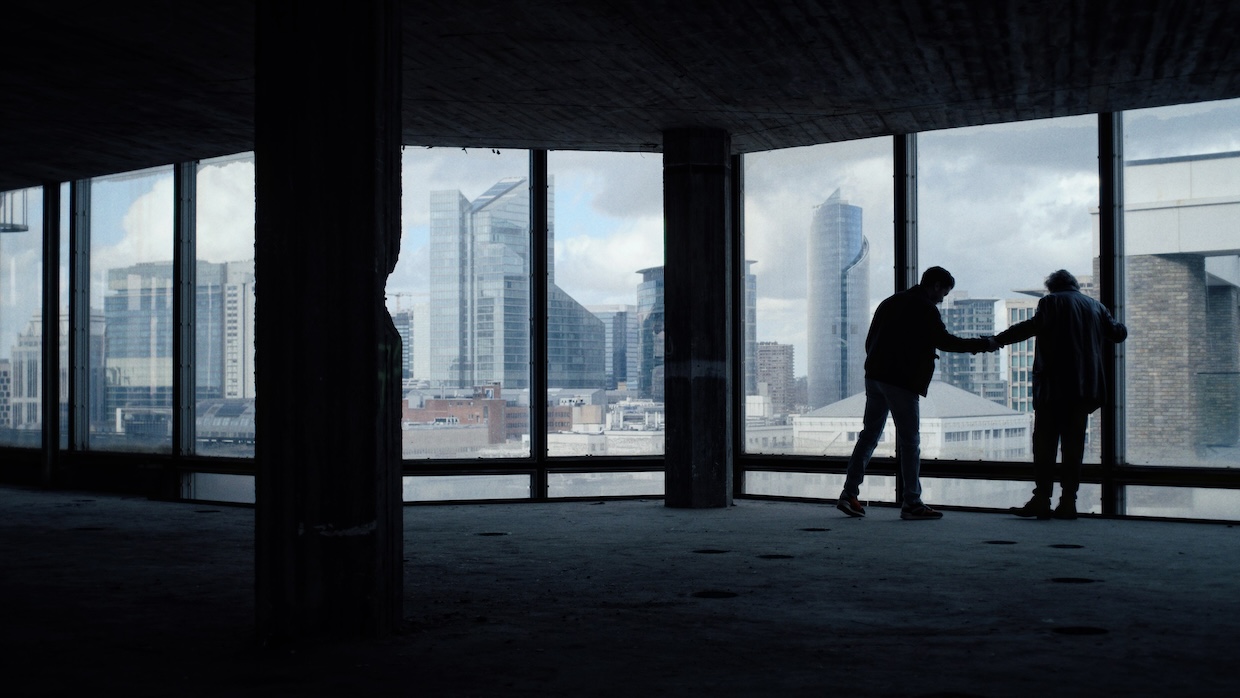 Death Will Come
Death Will Come The biggest headline of the 77th Locarno Film Festival wasn’t a movie but a man: Bollywood megastar Shah Rukh Khan, who attended to receive a career achievement award as a reminder (none is needed) of the role red carpet celebrity plays in drawing money and attention to festivals which can then, aspirationally, redirect both towards smaller title. But even as the whole idea of “cinema” requires increasingly vigilant caretaking, those festivals themselves are nearly all in financial trouble. When I got this job at Filmmaker a decade ago, companies who’d invested a lot of time and money in VR were sweatily trying to make it a thing, and the phrase “the intersection of storytelling and technology” (one which could have applied just as well to movies or TV at their inception, but let that pass) was getting tossed around a lot. That initiative didn’t take, and now we’re being inundated with relentless advertising for AI, but in Christoph Hochhäusler’s Death Will Come it’s still time to dunk on wearing helmets and how stupid they look, taking me straight back to 2014.
Crime lord Charles Mahr (Louis-Do de Lencquesaing) is introduced at a meeting with rivals who want to be potential collaborators. They propose that he invest in a forthcoming VR Erotic Center, whose clients will strap on the headgear and copulate with latex dolls; Mahr puts on a helmet, sticks his fingers down a prototype’s mute mouth and walks away unimpressed by this potential rival for flesh-and-blood sex workers. The stage is set for a traditional crime movie showdown between an older warlord who holds on to traditional values in a world that’s rapidly changing for the worse and younger, less scrupulous rivals. The self-consciousness of the genre exercise is in keeping with the neonoir-adjacent work of Hochhäusler’s Berlin School compatriots like Christian Petzold (in films like Jerichow) and Thomas Arslan (In the Shadows); likewise, this is as engaged with making explicit the subtexts and mechanisms of its narrative conventions as actually executing them. In the case of Death Will Come, this means not just the VR angle but Luxembourg’s increasing prominence as an international co-financier, foregrounded in an opening sequence taking place there (although, hilariously, the film mostly unfolds in the more dismal portions of Brussels). This is all theoretically just right for Locarno, whose well-intended if slightly cringey slogan this year was “Cinema Forever.” (Though it’s worth noting the festival also had a small showcase, presumably in return for decent sponsorship funds, for two VR pieces—one from last year, the other three years old. The revolution is slow to arrive!)
A quasi-iconic actor in his own right currently aging into a puffy-latter-day Jean Gabin mode, de Lencquesaing’s Mahr is a figure of more dubious nobility than that archetypal performer. After one of his couriers is assassinated, Mahr hires Tez (Sophie Verbeeck) to find out who did it and enact retribution; it’s a present for any actor to play a world-weary but impeccably cool assassin, and she executes that assignment faultlessly. The plot is simple in its trajectory (follow the criminal trail to the end) but extremely complicated in its incidental particulars and continuously punctuated by opaque interludes and metaphors. (What does a stolen Crespi painting of Hecuba blinding Polymnestor, whose citation must be symbolic, have to do with Tez and her blind other boss, a seemingly psychic woman who urges her to flirt with a bartender and smiles in satisfaction at what she feels but can’t see?) There’s only one big action setpiece, an admittedly exciting shootout about 75 minutes in, whose self-conscious delay of tension is in keeping with the whole enterprise. As an exercise in fatalist cool, Death Will Come moves briskly, even if it seems to be taking place both now and a decade ago for reasons that seem less deliberate than merely out-of-date. That’s not just thematic but in the pallid blue-and-orange color palette, a faded version of 2010-coded color correction tics that might just as well be the product of laziness.
A different kind of flashback, Ben Rivers’s Bogancloch is his second feature and third collaboration with UK hermit Jake Williams. Rivers first filmed him for 2006’s uptempo short This is My Land, where the massively bearded and somewhat ferocious-looking Williams spoke in an incongruously reedy, high-pitched voice. In 2011’s Two Years At Sea, the pace went down; now silent and projecting weathered stoicism, Williams’s daily routine was captured in lustrous, hand-processed, idiosyncratically pockmarked black-and-white 16mm. If Two Years at Sea was the visual equivalent of a drone album, its signature shot a massive durational study of the ripples produced from tossing a stone into the lake from start to extremely long finish, Bogancloch is more MOR in offering up a near-classical visual grammar. On one level, this isn’t surprising; the prolific Rivers has tried a variety of modes in his solo work, not all of which I’d be able to blind ID as the output of the same person, and sometimes merges his voice indissolubly with that of co-directors like Ben Russell (A Spell to Ward Off the Darkness) and Anocha Suwichakornpong (Krabi 2562). New choices here include having Williams speak more than ever and shorter shots breaking down his daily routine; I could have wished for much longer gazes at e.g. smoke rising from a stove, which is cut away from almost immediately to show the rest of what Williams is doing that afternoon.
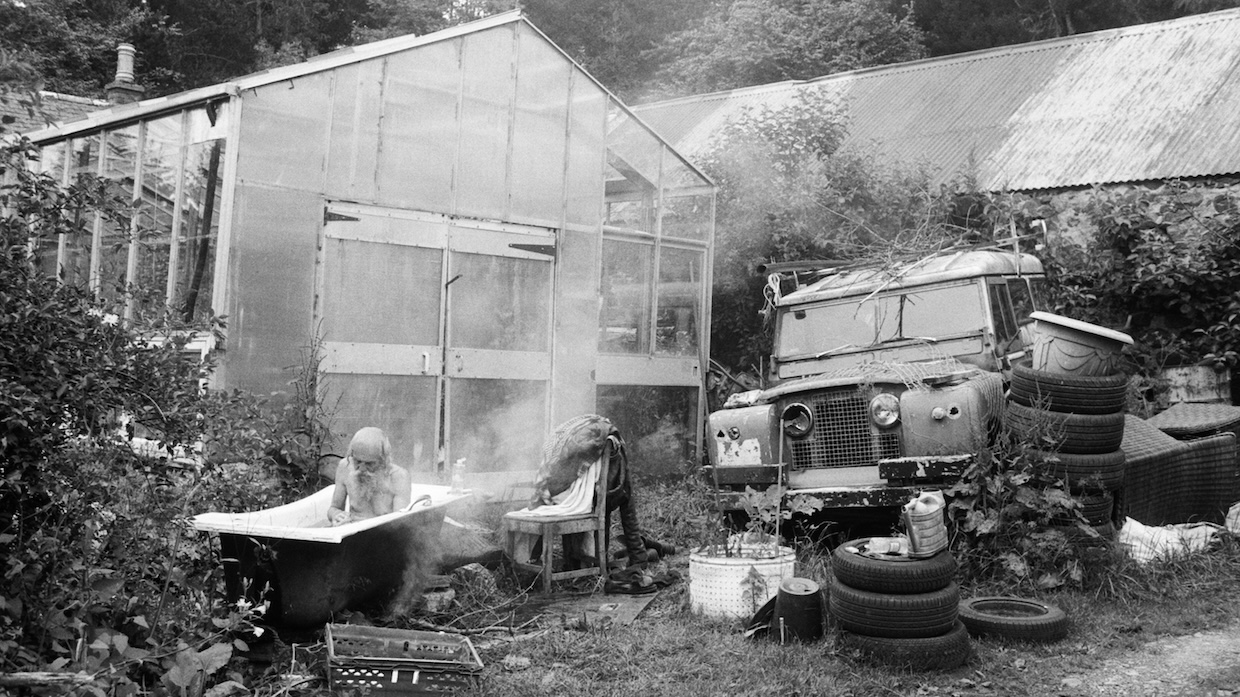
Boganloch climaxes with a drone shot going up, up and away from Williams submerged in a tub outdoors; I pictured the 16mm camera perilously swaying in the breeze, but the film’s overall effect is less spectacular than its predecessor’s. The look remains the same, warping throughout shots of often startling beauty, like one of a forest where the grain swimming between trees radiates different densities. The overall effect is a little uncanny; both identifiably “filmic” and digitally pinned down; it’s a celluloid-based work that’s almost impossible to imagine seeing projected on celluloid, but which really does look finished in this both-and-neither form. Rivers intends to keep revisiting Williams every decade or so; more silence next time, please!
The third feature by Switzerland’s admirably idiosyncratic Ramon and Silvan Zürcher, The Sparrow in the Chimney is a frustrating synthesis of their previous two films. Collaborators whose precise roles change from project to project, the twins are developing their own separate voices and intend to direct solo; this time, Ramon is the writer and director, Silvan the producer. As in 2013’s excellent The Strange Little Cat, what should be a low-key family gathering generates increasing bad mojo in a confined space; as in their less excellent follow-up, 2021’s The Girl and the Spider, that tension eventually leaps out of exactingly framed, unorthodoxly structured naturalism into an overtly hallucinatory register. Sparrow begins by once again demonstrating the brothers’ John-Carpenter-level facility with weaponizing off-screen space, leaning into meticulously locked-off interiors that are repeatedly unexpectedly disrupted, often by animals; a cat jumping over the windowsill, disappearing and then re-entering from the left foreground, invisibly coming closer in between, juices an early view of a kitchen.
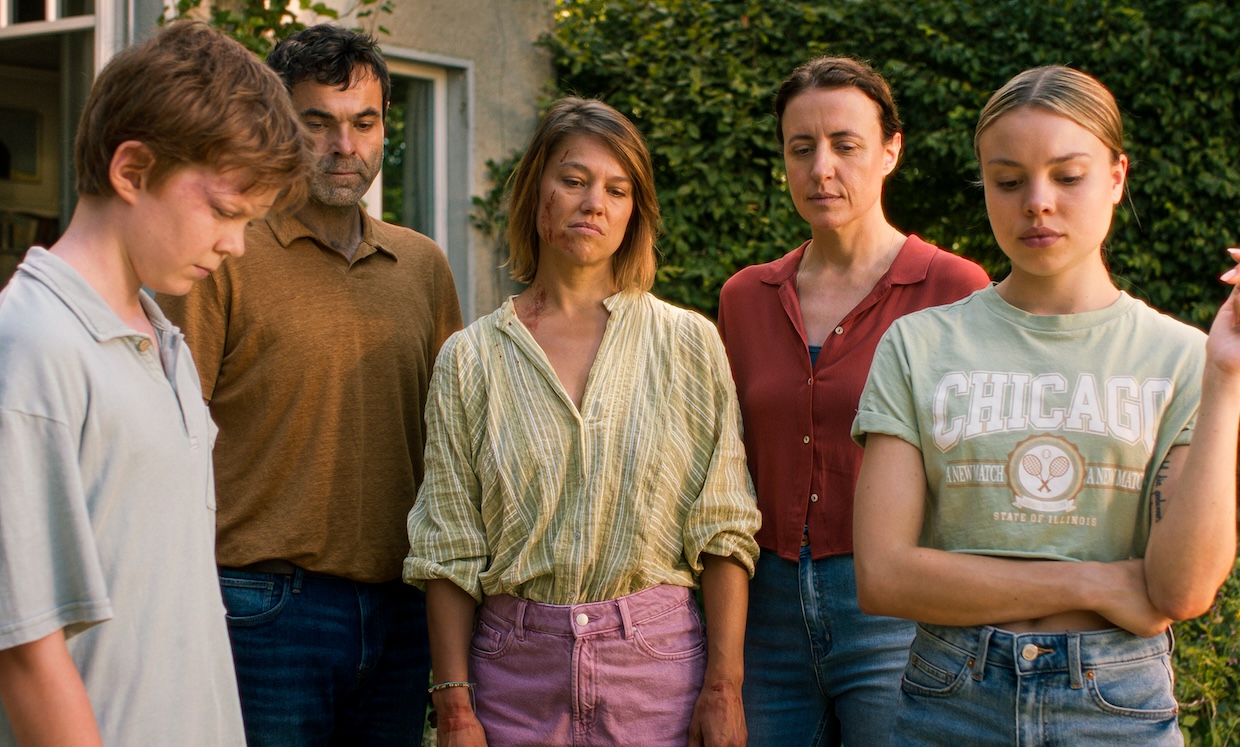
Chickens, dogs et al. proliferate on a scale even greater than the first two films, surrounding a family in the countryside in which pretty much everyone seems to have some kind of mental illness. That’s especially true of mother Karen (Maren Eggers), whose hostility towards all around her poisons the communal well. The mothers of the Zürchers’ filmography trend monstrous; here, that manifests with a degree of hostility even Noah Baumbach might find excessive, as in an exchange between Karen and her furiously estranged daughter Johanna (Lea Zoe Voss) after she overhears a typically fractious interaction between the mom and her husband: “Why don’t you get divorced?” “To make your life hell.” Part of what I liked most about Strange Little Cat was the ways it generated surprise from both its framing and unexpected structure, low on overt incident but subtly discombobulating; that the Zürchers’ subsequent films have leaned into greater degrees of melodramatic hyperbole isn’t where I want them to go.
That premiere was packed, with nearly every seat in the 2,800-capacity Palexpo taken—presumably Swiss national pride1 at work, as another premiere screening I attended there, Marta Mateus’s Portuguese Fire of Wind, brought out a creditable but less overwhelming audience. This was the most traditionally “Locarno-esque” work I saw during my six days there—i.e. a very specific sub-species of “challenging festival film” heavily influenced by Pedro Costa, who serves as one of the producers. A brief prologue of sorts shows grape-pickers at work while a managerial shithead yells at them to go faster; this abusive quasi-motivation, naturally, constitutes the sole form of labor he’s performing. When the laborers mosey home, management sics an ox on them; they all shin up trees and stay there for roughly half of the 72-minute production.
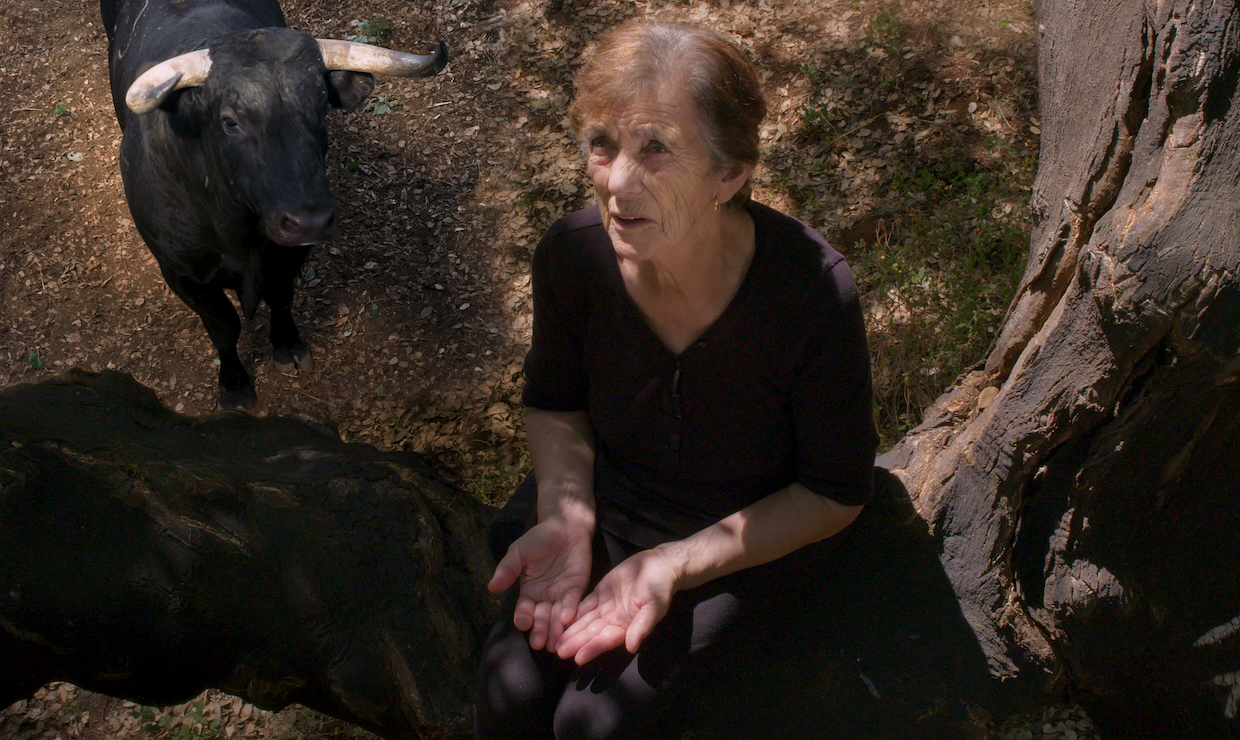
While one worker (Soraia Prudêncio) initially appears to be the focus, Mateus puts dozens upon dozens of non-performers through their declamatory paces, highlighting face after face for one or two lines only. Their rough-hewn, almost uninflected approach to dialogue centered around revolutionary concerns (bread, land etc.) is the Straub/Huillet component, while the daytime shots of each—mildly sweaty profiles from just below—call to mind the Eisenstein of Que Viva Mexico! The images become more familiarly Costa-esque in their chiarascuros as sunlight fades to night, suggesting something like his take on The Jungle Book as the ox roams below, disrupting each shot seemingly at will, adding a pleasing touch of randomness to a largely programatic endeavor. If the narrative logic is opaque, the general chronological trajectory and idea is clear, beginning in the present and moving backwards in time through various historical iterations of oppression and rebellion, explicitly invoking Salazar’s 20th-century dictatorship before costumes walk the film back to a 19th century conclusion. If Fire is familiar in both its austerity and quasi-revolutionary solidarity (always an odd idea when the initial audience is overwhelmingly well-heeled Swiss people, a standard festival paradox), Mateus’s command of her craft (she co-DP’d and co-edited) is clear and her service in maintaining a particular lineage of severity admirable.
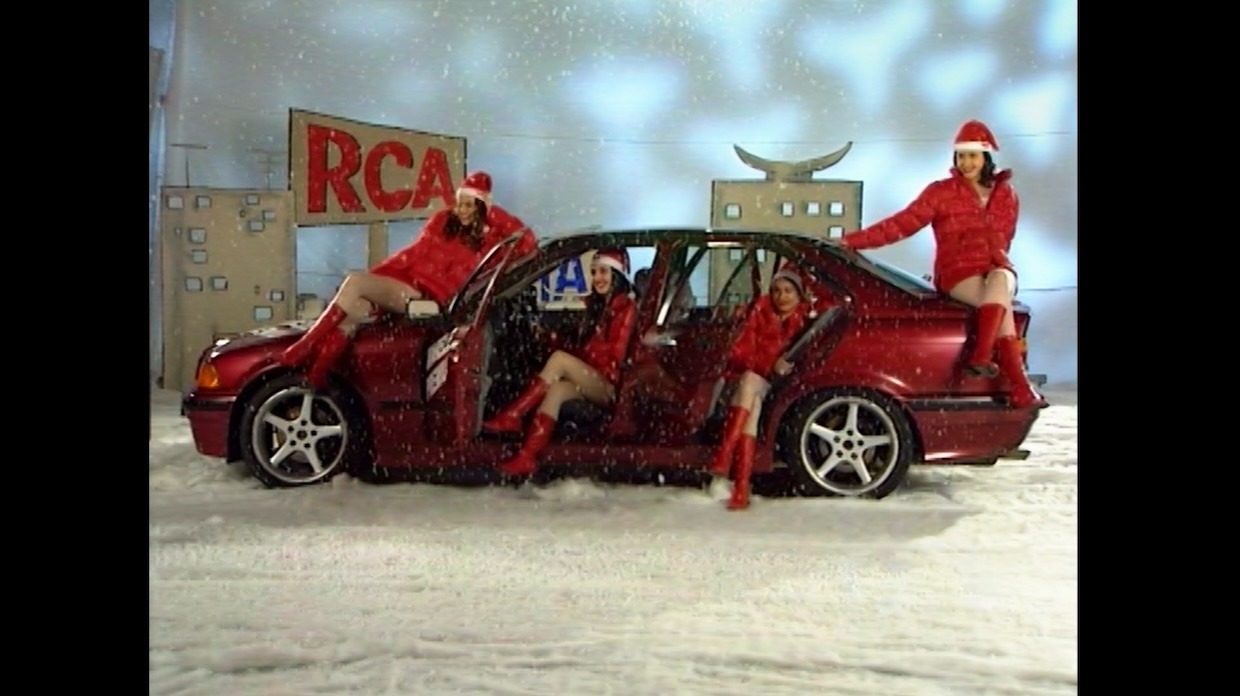
After last year’s Do Not Expect Too Much From the End of the World, Radu Jude returned with a double feature of new work shown in one solid 133-minute lump—in part, I suspect, because neither is substantial enough to merit stand-alone showcasing. First was Eight Postcards from Utopia, co-directed with philosopher Christian Ferencz-Flatz, which supercuts hundreds of Romanian TV advertisements from the post-Ceaușescu years into 72 minutes structured as eight chapters and an epilogue. I would have preferred to watch the inevitably oft-campy adverts play out in full, but understand the desire to pointedly juxtapose them, a plainly discernible form of artistic intervention that hopefully prevents the results from registering merely as a Drafthouse pre-show kitsch assembly. But there are two problems, one being that the juxtapositions aren’t particularly interesting either formally or politically—aside from the seventh chapter, “The Anatomy of Consumption,” which almost entirely removes sound from the equation to better foreground strung-together sequences of covetous gazes and lustful smiles at products, the sexualized semiotic building blocks of advertising-as-desire brought into clear relief; everything else is a pellmell assemblage of general yuks, loosely organized by clearly stated thematic preoccupations (like chapter eight, “Masculin Feminin,” per Jude’s lodestar Godard). Still, that points to the other problem: unless you were expecting Jude/Ferencz-Flatz to take a bold stance in favor of conspicuous consumption and a fully materialist society, there are no surprises in the thematic drift, which is as blunt as the title; there’s nothing to do but note the obvious about unsophisticated, button-pushing advertising.
Meanwhile, Sleep #2’s title card declares it to be a “desktop documentary,” although it’d be more accurate to downgrade that to a “one-browser-tab doc,” as it’s assembled from a year’s worth of streamed webcam footage of Andy Warhol’s grave. The affinity with Warhol’s own monumental durational experiments, including the first Sleep to which this is cheekily and nominally a sequel, is conceptually clear, but the image’s massive pixelation, which almost seems to be a 56K flashback to the early aughts, (very rarely!) introduces something unexpected to an otherwise sedate stream of still lives, graveside selfie-taking and other anodyne interactions. It’s not at all clear to me that either film would be programmed at a major festival if not for who made them, let alone both in one lump sum. In interviews, Jude likes to talk about embracing imperfection; still, I think it wouldn’t hurt if he were to try for perfection, secure as he would be in the knowledge that since the immaculate is beyond human capability, error will be introduced regardless.

Introducing Dear Beautiful Beloved, director Juri Rechinsky thanked the 11:00 AM audience for being inside instead of swimming in the lake before noting that it was the 899th day of the Ukrainian invasion, suggesting a certain hopeless inertia. The Turkmenistan-born/Ukrainian-raised/Austria-based filmmaker’s first feature, 2013’s Sickfuckpeople, is a fairly merciless, occasionally mildly stylized portrait of Ukrainian drug addicts doing their thing in derelict basements, with a tour-de-force standout sequence when one returns home to look for his mom and wanders a snowy village where her former partners (one very drunk) denounces her on the street; suffice to say Rechinsky is comfortable with abjection. I’m not really sure what to say of his contribution to the Ukrainian empathy-raising-genre, other than to note that it’s likewise exceedingly grim, even by the standards of what’s unfortunately become a mini-genre.
Dear Beautiful proceeds along two primary tracks, the first being the transport of soldier’s corpses from their pickup and loading into body bags onto the field to their final funereal destination; an older man (nickname: “Bulldozer”) and younger volunteer transport 17 dead, whose weight makes the back of their vehicle sag perilously as they pull out. The other narrative strand follows the transport of extremely unhealthy elderly people from their homes to way-station nursing homes to other way-station nursing homes. To be fair, given the variety of their ailments (all terrible), pervasive deafness and a collective senility that requires their caretakers to repeatedly yell basic information, it’s not like this section would be any lighter if it originated during peacetime. I’ll say this for Rechinsky: unlike a lot of nonfiction filmmakers who systematically dilute grim material with systematic doses of “warm interactions” or other such leavening moments, he has no such impulse, but I was left as confused as the director seemed to be about what watching the film might achieve for anyone artistically or politically.
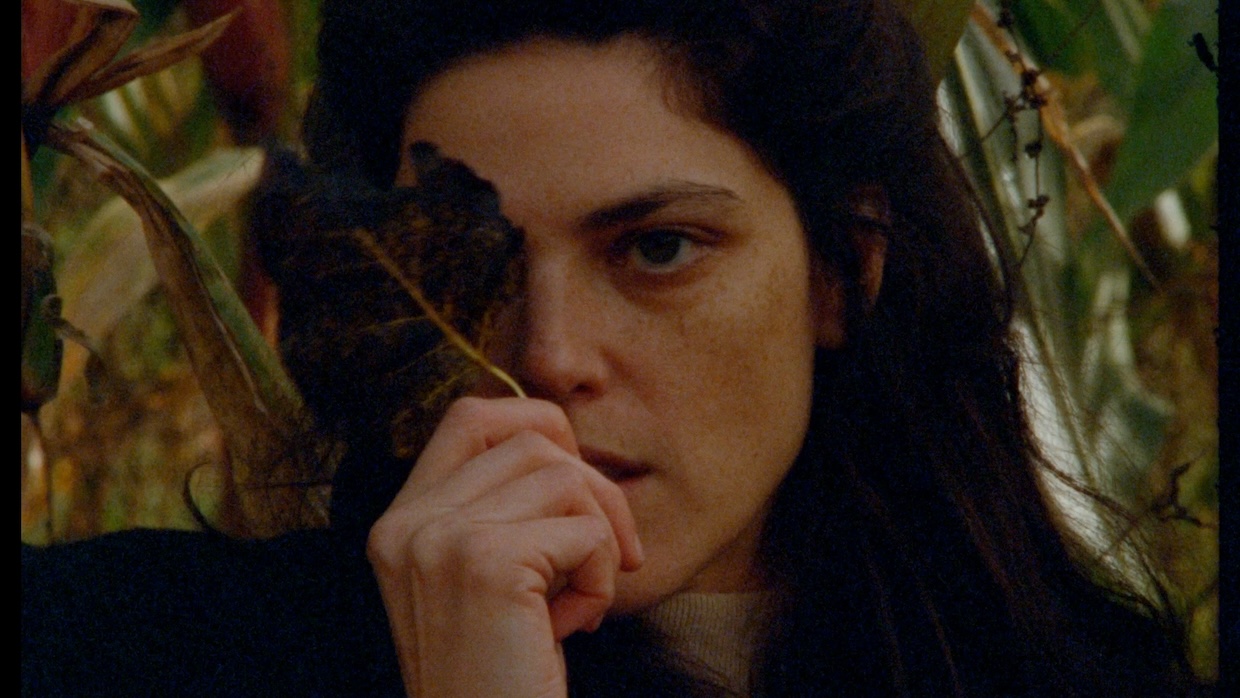
Now through the grumbling portion of the dispatch, it’s time to finish cheerily with my two favorite new films2 from this year’s Locarno. Though the sole credited director of Invention, Courtney Stephens shares the opening “A Film By” credit with lead performer Callie Hernandez, who won Best Actress for playing “Carrie,” a riff on herself, as does everyone within the film. Hernandez’s dad was an alternative medicine physician of sorts; his death, and the subsequent estate-dissolving fallout, are the starting prompt for a story that’s often unexpectedly close to comedy. It’s a not very funny situation—the sudden death of a father whose legally dubious actions on multiple fronts have left a huge mess for his overwhelmed daughter to clean up—but the opening scene establishes a light touch and fine eye for American eccentricity (division of rural grotesquerie) as a funeral home employee clicks through chintzy automated organ tracks before landing on what (somehow, and with no audible degree of difference from its fellows) is the right one for this occasion. The homeopathic realm can often slide into the conspiratorial (why was Dr. Hernandez’s secret knowledge suppressed!), so it’s not necessarily surprising when one of the late physician’s grateful ex-patients, upon learning of his death, asks if he was “offed.” He wasn’t, but he did leave behind a very confused estate, including the wonky magnetic-ray-healing (?) titular invention, whose patent rights Carrie can either inherit or not. A withdrawn Hernandez hits the investigative trail, inciting droll encounters with people who knew her father, acting as an in-mourning straight woman to their eccentric comic babbling. Those conversations include three with an estate trustee possessing a strangely indexical expertise in patent law, explicated by James N. Kienitz Wilkins at the rapid-fire speed of his short films’ comic monologues. Excerpts from the real-life Dr. Hernandez’s collection of TV appearances and video tapings took me straight back to the 90s when the physician lists the ten most purchased items at American grocery stores, Budweiser and Winstons among them.

My best of fest was Virgil Vernier’s 100,000,000,000,000 (its onscreen title, spelled out in the festival program as Cent milliard milliard). Where his previous feature, Sophia Antipolis, took place in and around the titular tech park and nearby towns like Antibes, 100,000,000,000,000 leaps to the other side of the French Riviera to capture the inherently tremendous oddity of Christmas in Monaco. The lightly plotted film has sex worker Afine (Zaharia Bouti) spending his holidays alone; while his housemates go off to Dubai, he services clientele who haven’t left the city, hanging out between assignations with Serbian babysitter Vesna (Mina Gajovic) and her pre-teen charge Julia (Victoire Kong). Vernier trains a sharp eye on the trickle-down social economy of those who service the ultra-wealthy and the very precisely graded power gaps between each: the drivers who ferry Afine and his friends are a cut below, the clothing store employee who stands in awkward silence with Afine as their mutual client tries on a new dress subtly conveys discomfort with his obvious form of employment.
Like Invention, 100,000,000,000,000 is chilled-out despite fraught subject matter, pivoting on the growing warmth of the relationship between Afine and Julia and verging on the overtly sentimental (an observation, not a complaint; I could use a hug as much as anybody). The specificity of the rarely seen setting is a study in bluntly externalized wealth—yachts, helicopter landing pads and mansions that add tremendous production value. Despite its locale this is, counter-intuitively, a more modestly created film, one Vernier says was hard to raise funds for and hence was shot in three weeks. (Antipolis financiers Arte and the CNC, among others, aren’t involved in this follow-up, whose lack of high-profile funders is attested to by the fact the film begins immediately with its first shot rather than a parade of logos.) As in Antipolis, Vernier draws outstandingly lived-in work from performers, who, in his very specific method, are encouraged to give performances that retain their natural presences and mannerisms while enacting lives that are very different from their own. That, along with the unfamiliar Monaco scenery, may explain 100,000,000,000,000’s lightly uncanny affect; it’s a naturalist drama that’s tonally somehow floating serenely above itself.
1 A curio: while the festival has a section, Swiss Panaroma, for films from the country, that did not include the nation’s highest-grossing film of last year, Bon Schuur Ticino, Ticino being the canton where Locarno is located. Logline: “A crazy referendum throws Switzerland into a state of emergency. The adoption of the ‘NO BILANGUE’ initiative sanctions that from now on only one national language will be accepted: French. Many German-speaking Swiss enter a crisis. Walter Egli (56), who works for the Federal Police and must ensure that the transition to monolingualism goes smoothly, is one of them. Although he barely speaks French, he must travel to Ticino with a French-speaking partner to investigate a Ticino resistance group that is fighting against monolingualism with all the means at its disposal.”↩
2 This year’s sidebar retrospective on Columbia Pictures, curated by Ehsan Khoshbakht, considerably jazzed up my festival; I went and saw five deep-cut 35mm prints over five days. Along with those unfamiliar titles, I also saw something I’ve never seen before; because the print of Frank Tashlin’s The First Time included a reel with no sound, that section was projected with a digital sound file, which lagged about a second ahead but was definitely better than a digital changeover. ↩
